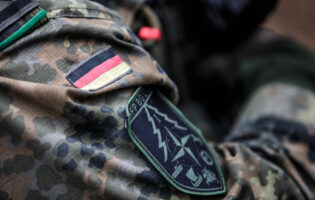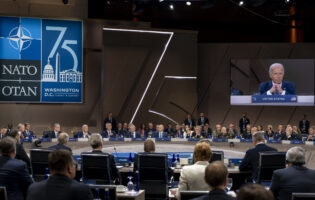Lessons of German Unification

Robert B. Zoellick
Robert B. Zoellick was lead U.S. negotiator in the Two-plus-Four process of German unification. He served as U.S. trade representative and U.S. deputy secretary of state during Republican administrations, as well as president of the World Bank. He is a former AICGS Trustee.
AGI is pleased to present this collection of essays reflecting on the 25th anniversary of German unification in October 2015. We are grateful to those who have contributed to this collection, all of whom have been affiliated with and supported the Institute in many different capacities. These essays leave us with thoughts not only about the past, but also about the future of German-American relations. Be sure to check back throughout the week for additional insights.
Twenty-five years ago, in October 1990, Germany achieved its unification. The Berlin Wall had been accidentally opened only the prior November. Events moved so quickly that they seemed pre-ordained. But were they? What lessons might we learn?
First, the story of German unification underscores the importance of anticipating critical trends even if one cannot predict specific events. In late 1988, Soviet President Mikhail Gorbachev had become a symbol of hope, and the German public was especially charmed. Elsewhere in Central Europe, restive publics were stirring and testing the boundaries of the Soviet empire’s new rules. Newly-elected President George H.W. Bush and Secretary of State James Baker realized that the center of geopolitical gravity was shifting to Central and Eastern Europe and that Germany would shape the course of events.
In May 1989, Bush gave an interview that signaled his support for German unification, well ahead of events. That same month, his administration advanced a dramatic proposal to cut and equalize conventional forces in Europe, leading to a successful NATO Summit that challenged the Soviets to withdraw large armies from Europe. The new focus also eased a contentious debate with Germany about modernizing the short-range nuclear forces that remained after President Ronald Reagan’s elimination of intermediate missiles. “The shorter the missiles, the deader the Germans,” said one German.
Bush called for Germany to be a partner in making Europe “whole and free” when in Mainz in late May; in the summer, Bush’s visits to Poland and Hungary signaled a direct interest in political change in Eastern Europe. Without knowing how events might unfold, the United States was positioned to manage big changes.
Second, the Bush administration viewed the challenges of unification within the context of seismic shifts in Europe. The United States wanted Germany to be a strong democratic partner in building a new Europe and transatlantic relationship. The United States resisted limitations on German sovereignty to avoid resentments by a future generation. To reassure other Europeans and the Soviets, the United States pressed for a unified Germany within NATO and the European Community. Borders would need to be affirmed. The Soviets, too, were offered opportunities to participate in Europe’s new security system, and the United States and Germany tried to address legitimate concerns. Bush sought to avoid a “Versailles Victory” that invited its own destruction. The U.S. president’s active leadership provided reassurance.
Third, the administration made a critical, practical judgment about facts on the ground: that the German people would be the driving force for national unity. Many experts thought Easterners would seek a “third way” between capitalism and communism. Baker could see from his visits that East Germans wanted what their cousins had in the West, not a new socialist experiment.
This judgment had two important implications. Unification would be a takeover by the Federal Republic in the West, not a merger. And events on the ground would create continuing momentum for unity. But if diplomacy stalled, there could be a crisis of massive migration or uncontrollable protests.
Fourth, the United States channeled the diplomacy into the “Two-plus-Four” process. The name emphasized that the priority was to have the two Germanys lead on internal unification. The four allied powers of World War II—the United States, the USSR, the UK, and France—would terminate their legal rights dating to 1945. The Two-plus-Four would also be a “steering group” encouraging changes in NATO, the Conference on Security and Cooperation in Europe, the conventional forces negotiations, and German-Soviet economic arrangements.
Some feared this process would give the Soviets a vehicle to be disruptive. The Soviets already had leverage through 380,000 troops in Germany and their Four Power legal rights. Accidents were always a risk. Americans perceived that the pace of events had thrown the Soviets off balance; there was a need and opportunity to help them explain an acceptable outcome. During times of flux, skillful diplomacy can help one’s counterparts determine how best to achieve objectives or even help define those objectives.
Fifth, U.S. statecraft recognized the need to communicate with the public—especially in Germany and Europe—to generate support for the diplomatic strategy. Given the importance of the public momentum within Germany, Bush and Baker emphasized that America stood by Germany. Many in Europe did not. The announcement of the Two-plus-Four process in February 1990 sent a powerful signal to East Germans in advance of the March election that unification was truly possible, and Chancellor Helmut Kohl’s pro-unification stance triumphed. By remaining in the forefront, the United States lessened the risk that Germans would perceive NATO membership as a stumbling block. At the same time, Bush and Baker needed to assure publics elsewhere in Europe. Bush managed a discreet mediation with the Poles to provide comfort about the German border. The new European system needed to offer security as well as freedom.
Sixth, Bush and Baker built good personal ties and trust with their counterparts, not only in Germany and with reluctant allies, but also with the Soviets. Bush was criticized for not showing more emotion, but he was more effective because Gorbachev recognized that Bush would not exult over his problems. The relationship between Baker and Soviet Foreign Minister Eduard Shevardnadze enabled Baker to share changes in NATO in advance of NATO’s agreement so Shevardnadze could be primed to embrace them before Soviet hardliners resisted.
Seventh, timing was vital. It took only ten months between the dramatic fall of the Berlin Wall and the signing of the Final Settlement in September 1990. By December, Shevardnadze had resigned; in August 1991, Gorbachev faced a coup and the Soviet Union was nearing its end. After the August 1990 Iraqi invasion of Kuwait, Bush and Baker turned to assembling an international coalition to reverse aggression. The deal on German unification was sealed just as the window of opportunity was closing.
Finally, the American public expressed strong support for unification. There were echoes of old fears in elite media circles. But Americans instinctively associated with the desire of the average German to unify in freedom. The U.S. focus on the future—not an obsession with the past—enabled American diplomacy to lead in ending the Cold War peacefully and laying a foundation for the transatlantic and European future.
Robert B. Zoellick was an Under Secretary of State and lead U.S. negotiator in the Two-plus-Four process of German unification.









